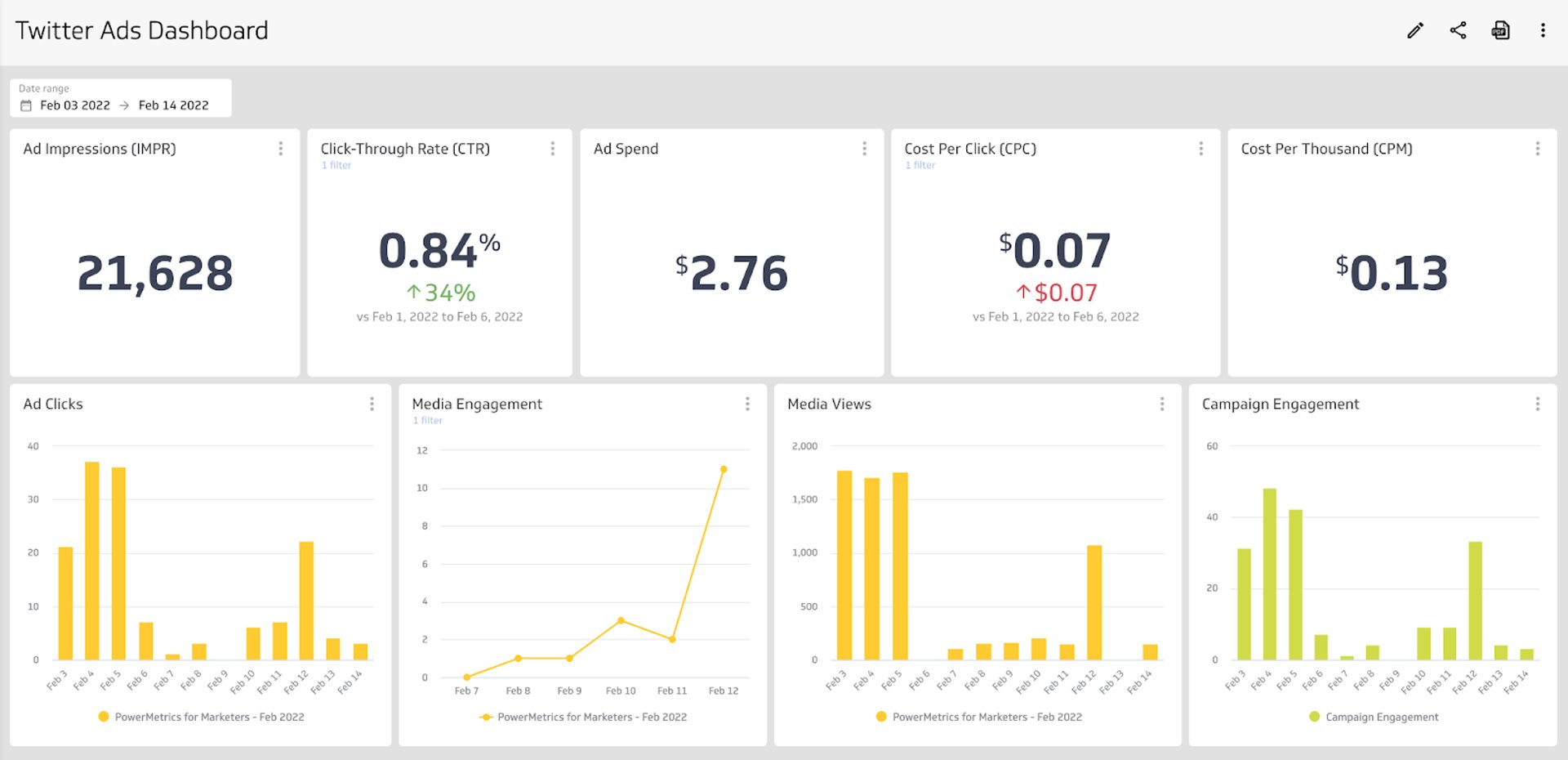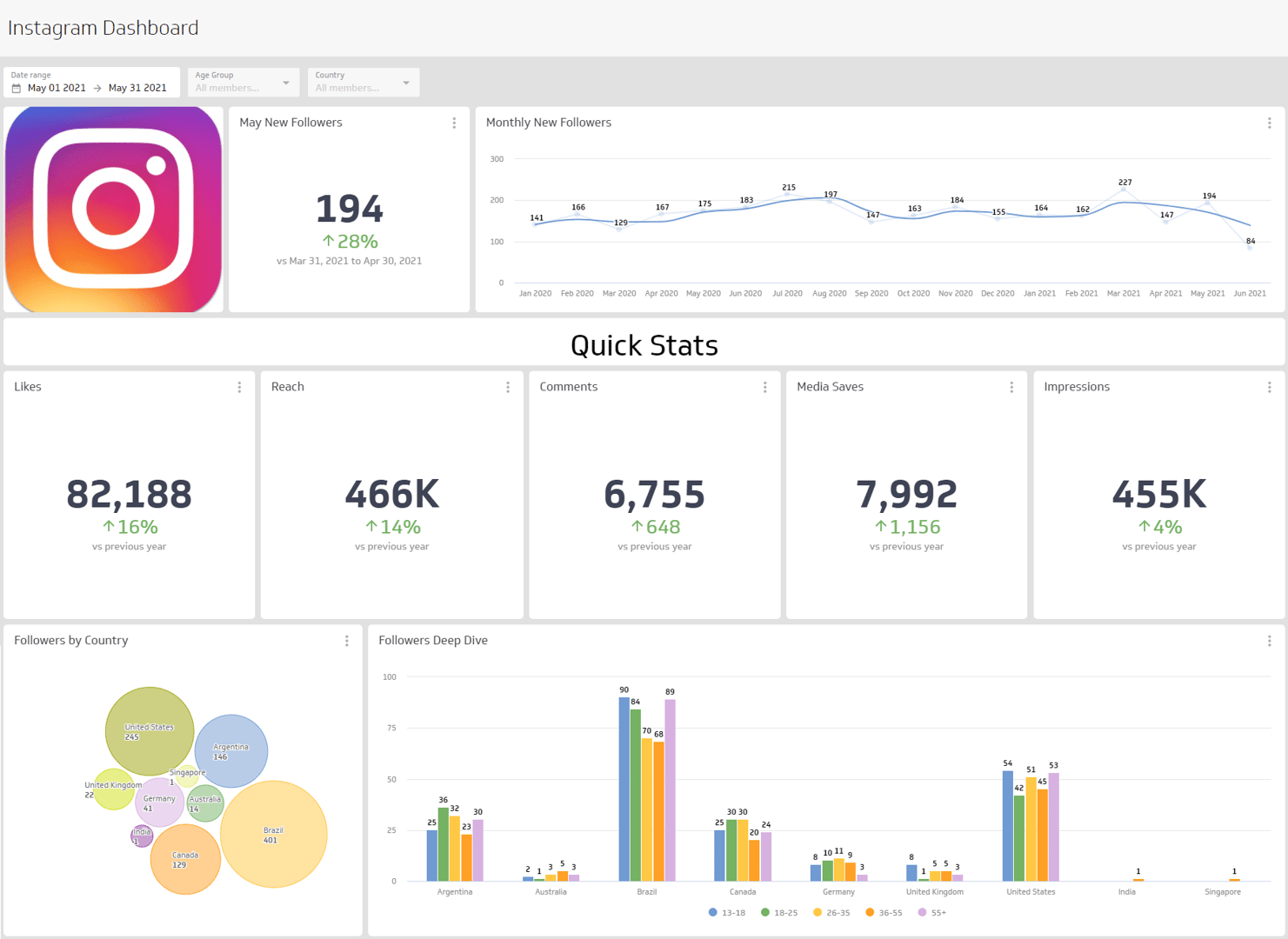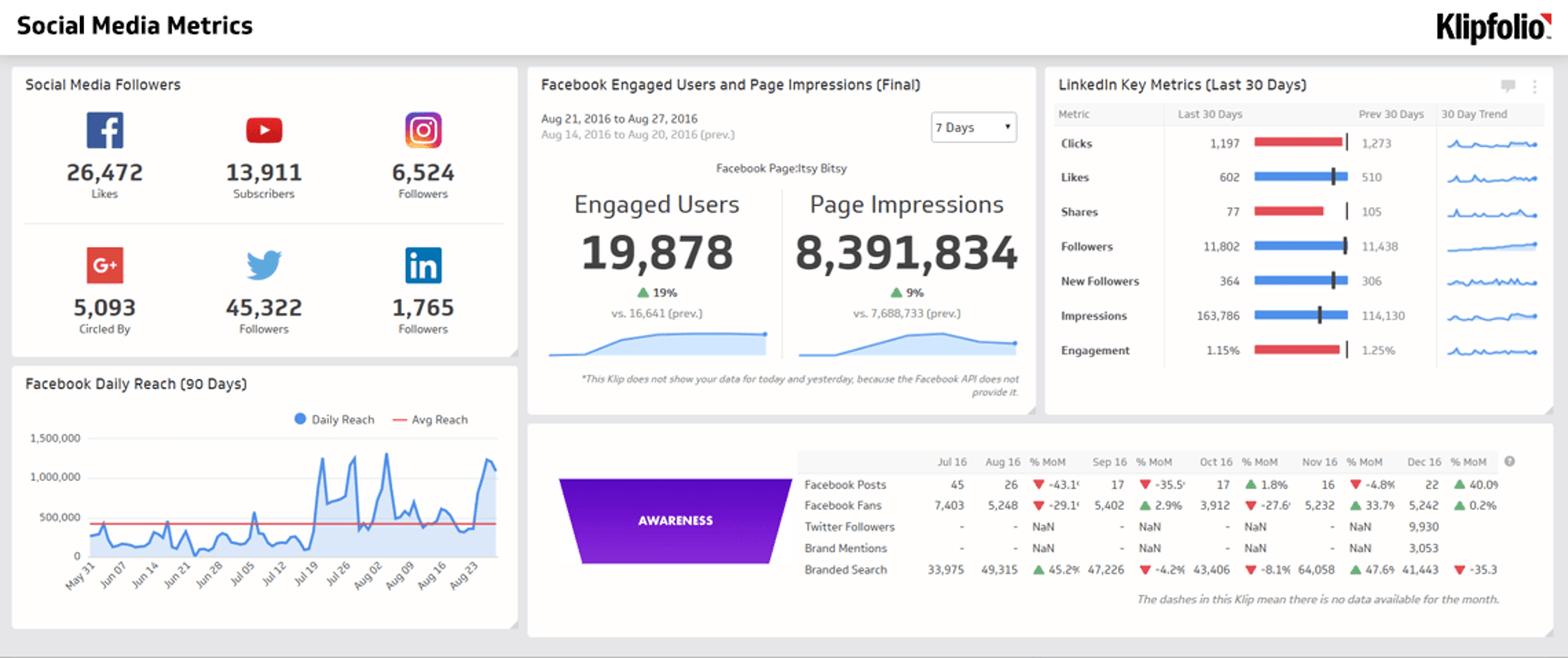Twitter Ads Dashboard
Track your paid social media performance, from ad spend to engagement, all in one place.
What is a Twitter Ads Dashboard?
A Twitter Ads dashboard monitors the key metrics and KPIs for your paid social media marketing. When you place your Twitter Ads metrics on a dashboard, you can easily understand how your ads are performing, whether you’re reaching your target audience, and the level of engagement with your content.
When you track your Twitter Ads on a dashboard, you can answer important questions like:
- How many people are my ads reaching?
- How does my audience engage with my ads? Are they clicking a link or converting?
- What is my ad spend?
A Twitter Ads dashboard provides the insight you need to determine if Twitter is a successful channel for your paid advertising and if it is helping you convert users into customers.
What metrics should you include on a Twitter Ads dashboard?
Ad Clicks
Ad Clicks is a marketing metric that counts the number of times users have clicked on a digital advertisement to reach an online property.
Ad Spend
Ad Spend is the amount of money spent on specific ad variations within a specific campaign or ad set.
Click-Through Rate (CTR)
Click-Through Rate (CTR) is the percentage of clicks on your link that generate impressions.
Cost Per Thousand (CPM)
Cost Per Thousand (CPM), also called Cost Per Mille, is a marketing term used to describe the price of 1,000 advertisement impressions on an advertiser's webpage.
Post Likes
Post Likes is a measure of the popularity of social media content on platforms such as Facebook and Twitter.
Content Engagement
Content Engagement measures all engagements resulting from content generated in a social media account.
What type of visualizations work best on a Twitter Ads dashboard?
Building a Twitter Ads dashboard gives you insight into your ad spend, attributed engagement, and the growth of your paid marketing campaigns. The majority of the Twitter Ads metrics you put on your dashboard can be segmented by date and time, ad placement, or campaign.
With this in mind, let’s look at the data visualizations you can use on your Twitter Ads dashboard.
To compare values over a specific period of time
Temporal data visualizations, like bar or line charts, are among the most familiar data visualization types. Bar charts and line charts use an x- and y-axis so you can easily compare values over a period of time.
Bar charts or line charts
Let’s say you want to track your ad clicks each day. Use a bar or line chart to see how many clicks your ads received daily. This way, you can quickly identify any trends or causes for concern.
Summary charts
Summary charts display one numeric value and often include a comparison value. On a Twitter Ads dashboard, a summary chart is a great visualization to display your total ad spend or your click-through rate. When you use a summary chart with a comparison (either numeric or a percentage), you can easily identify positive or negative growth.
Benefits of a Twitter Ads dashboard
Putting all of your Twitter Ads performance and engagement metrics on a dashboard gives you a single source of truth for your ad data. When you put your Twitter Ads data into a Klips dashboard, you have the power and flexibility to adjust date ranges, pick the right data visualization to display your metric (versus the default table view within Twitter Ads), and share the information with your team. Klips allows you to add users and share your dashboards and metrics so you and your team can always be aligned on your social media performance.
Dashboard inspiration for your Twitter Ads
How do you know which Twitter Ads metrics to track? Here are a few Twitter Ads dashboards you can build in Klips to focus on specific areas of ad performance or engagement.
Track your performance on a Twitter Ads dashboard
Build a Twitter Ads dashboard that tracks your overall campaign performance. This dashboard will answer questions like:
- How many people saw my ads over a specific time period?
- What is the overall ad spend and cost per click?
- What is the click-through rate of my ads?
- How are people engaging with my ads?
Tracking your Twitter Ads metrics will help you answer these questions and adjust your social media marketing strategy based on your results.
Track engagement with your Twitter Ads content
How are users engaging with your ads? Build a Twitter Ads dashboard that displays your most important engagement metrics. This dashboard will help you answer questions like:
- Are users clicking through my ads to go to my website?
- How many people did my ads reach?
- What is the total number of engagements (interactions and clicks) with my ads?
Tracking these metrics will not only help you answer your questions, but you’ll also be able to segment your metrics by ad. This allows you to see which type of content has a better engagement rate and identify areas for growth or adjustment in your social media marketing strategy.
Track your advertising spend for your Twitter Ads
Revenue is a critical marketing metric. An equally important part of any social media strategy is the budget: how much are we spending on advertising, and are we recouping those costs through customer acquisition? Build a Twitter Ads advertising spend dashboard to answer questions like:
- How much money are we spending on advertising?
- What is our return on marketing investment?
- What is our cost-per-click?
Tracking these metrics will help you keep a close eye on your campaign budget and give you the insight you need to request a budget increase or re-allocate your spend.
What does success look like with a Twitter Ads dashboard?
A Twitter Ads dashboard is a reporting tool you can share with your team. It gives you insight into your campaign performance and engagement. When building and designing a dashboard, remember that everyone should be able to understand the data being presented. Clear visualizations that pull out key insights make for easy interpretation and answers.
Twitter Ads is one part of your overall social media strategy. The data displayed on your dashboard is a key component in optimizing or adjusting your approach to Twitter Ads and can be used to identify trends in audience engagement and behaviour. By centralizing this data, you move away from scattered reports and align your team, a core benefit of using Klipfolio Klips.
Related Dashboards
View all dashboards



